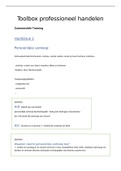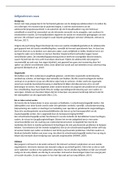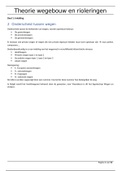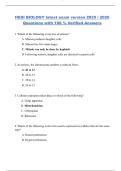Week 1: Analyzing the creative and cultural industries (CCI)
Article 1: Throsby, D (2008). Modelling the cultural industries. International Journal of
Cultural Policy
● Throsby (2008) discusses the definition and boundaries of the cultural
industries.
● Cultural goods require some input of human creativity and should be
attributable to an individual or group producing the good.
● In regards to cultural products, cultural goods require some input from human
creativity and should be attributable to an individual or group producing the
good.
● Cultural goods are not utilitarian goods, they’re for social and cultural reasons.
The article discusses the definition of cultural industries, the boundaries of
cultural industries, and examines six tools for economic analysis that can be applied to
cultural industries.
Question: Is it possible to find a common group of industries on which all of the models
agree?
the boundary condition
Cultural Industries = Those industries that combine the creation, production and
commercialisation of contents which are intangible or cultural in nature (UNESCO)
Cultural goods like artworks, music, literature, film share the these
characteristics:
- human creativity: there must be human input + some sort of
creativity
- symbolic messages: transmission of symbolic messages to those
who consume the goods / observe the ones consuming
- intellectual property: that can be attributed to particular
individual or group producing the good
Creative Industries = Those industries which have their origin in individual creativity,
skill and talent and which have a potential for wealth and job creation through the
generation and exploitation of intellectual property (DCMS 2001)
Creative goods like advertisements, graphic design, web design share
the following characteristics:
- human creativity: there must be human input in production and
manufacture
- goods & services: can be in the form of good or service,
- commercial use: predominantly used in commercial application
Cultural goods are valued by those who make them and those who consume
them, for social and cultural reasons. Not for their utilitarian or materialistic
functionality. Social and cultural evaluations at the very least complement the most
1
,probably actually go even beyond any other form of economic valuation. (cultural
value + transcends purely economic valuation)
In contrast, creative goods do not need to satisfy all of the other criteria that
would enable them to be cultural with the exception of requiring some level of
creativity in their production + manufacture.
The distinction between cultural & creative industries are important. Because
of estimates of contribution (economic perspective), policy implications and economy
analyses. Perspective changes which industry is included, this also affects policy
implications.
Throsby (2008) & EY (2015): Based on the kinds of cultural and creative
industries which are included in the study, it seems that WIPO model (discussed in the
article) was used. But if the Concentric Circles Model was used instead of WIPO, what
would have happened? The economic impact of EY study would drastically be reduced.
This is because instead of including all cultural industries that are involved directly or
indirectly in creating, manufacturing, producing, broadcasting and distributing
copyrighted works which is at the foundation of the WIPO model, the Concentric
Circles Model would include only those industries that are at the core of the cultural
industries. This means that those located outside of the concentric circles or the core
are deemed to be commercial and hence have lower cultural value. Using the
assumptions of the Concentric Circles Model, and including only certain core cultural
industries such as visual arts, books, music would mean that the estimates by the EY
study would be off by almost 700 billion US dollars.
Know the implications as classification systems in the cultural industries of other models:
- UK-DCMS model
- Creative industries are defined as those requiring creativity, skill and talent,
with potential for wealth and job creation through exploi- tation of their
intellectual property
- Symbolic texts model
- critical-cultural-studies tradition
- symbolic texts model places greatest emphasis on those industries that define
popular culture and that have the strongest orientation towards indus- trial
2
, modes of production; these industries form the core of this model and the
creative or ‘high’ arts are relegated to peripheral status.
- This approach differentiates between high and popular culture on the grounds
of their different power dynamics in regard to social class, gender, and
race/ethnicity.
- The processes by which a society’s culture is formed and transmitted are
portrayed in this model via the industrial production, dissemination and
consumption of symbolic texts or messages, which are conveyed by means of
various media such as film, broadcast- ing and the press.
- UNESCO Institute for Statistics (UIS) model
- covering industrial, occupational and product classifications
- In its application to the cultural industries, the model identifies five ‘core
cultural domains’: cultural and natural heritage; performance and celebration;
visual arts, crafts and design; books and press; and audiovisual and digital
media.
- Americans for the Arts Model
- This model is based on identifying businesses involved with the production and
distribution of the arts, labelled as ‘arts-centric businesses’
- The model was developed with an advocacy purpose in mind, the specific
intention being to demonstrate the economic importance of the arts in the
United States, particularly in regional and local economies.
- WIPO Copyright model
- The product groupings in the WIPO model are defined according to the content
of intellectual property in the output of the various industries; the model
includes a large group of ‘interdependent’ industries which are those related to
the means of distributing copyright material.
- This model is based on industries involved directly or indirectly in the creation,
manufacture, production, broadcast and distribution of copyrighted works
- The focus is thus on intellectual property as the embodiment of the creativity
that has gone into the making of the goods and services included in the
classification. A distinction is made between industries that actually produce
the intellectual property, and those that are necessary to convey the goods and
services to the consumer.
- Concentric circles model
- concentric circles model places the creative arts at its centre, because it
interprets them as producing output of high cultural content; moving outwards
through the layers of this model involves a continuous decline in the cultural
relative to the commercial content of industry output
- This model is based on the proposition that it is the cultural value of cultural
goods that gives these industries their most distinguishing characteristic; thus
the more pronounced the cultural content of a particular good or service, the
stronger is the claim to inclusion of the industry producing it
3
, - The model asserts that creative ideas originate in the core creative arts in the
form of sound, text and image, and that these ideas and influ- ences diffuse
outwards through a series of layers or ‘concentric circles’, with the proportion
of cultural to commercial content declining as one moves further outwards
from the centre.
● Each of these six models gives rise to a different set of industries that go to make up
the cultural production sector of the economy.
● The immediate implications of these results for the formulation of cultural policy are
apparent. Assessments of the economic importance of the cultural sector and of its
role in economic policy more widely will vary substantially according to the model in
use. If the cultural industries are interpreted primarily in economic terms, the policy
spotlight will clearly fall on those sectors producing the greatest growth rates in
employment, value of output, exports, etc. If cultural policy is directed more strongly
towards achieving a govern- ment’s artistic or cultural objectives, a different
configuration of the cultural industries will be preferred, and a different group of core
activities will be identified. A balanced policy mix might be best delivered by adopting a
view of the cultural industries in which the generation of both economic and cultural
value are given equivalent weighting
6 economic approaches + tools to analyzing and understanding the cultural industries
(think how each model might be useful for interpreting the models)
1. Industrial organization theory
a. market concentration
b. barriers to entry and exit (characteristics of market, product
differentiation)
c. degree of competition
d. Relevant primarily to those models oriented towards the commercial
production of cultural goods and services like the WIPO model, can also
be useful for nonprofit firms in certain conditions like non-price
competition.
2. Value chain analysis
a. Production chain with value adding stages from initial idea (creation),
the production of goods or services, their marketing and distribution,
until consumption.
b. Used by firms to analyze performance in different stages of the
production cycle
3. Inter-industry analysis
a. Focuses on ways in which output is produced and distributed in the
economy. Offers better understanding of direct and indirect effects on
an industry, on consumers, on governments.
b. Used to evaluate the economic impact of cultural policy.
c. Input-output analysis:
4
Article 1: Throsby, D (2008). Modelling the cultural industries. International Journal of
Cultural Policy
● Throsby (2008) discusses the definition and boundaries of the cultural
industries.
● Cultural goods require some input of human creativity and should be
attributable to an individual or group producing the good.
● In regards to cultural products, cultural goods require some input from human
creativity and should be attributable to an individual or group producing the
good.
● Cultural goods are not utilitarian goods, they’re for social and cultural reasons.
The article discusses the definition of cultural industries, the boundaries of
cultural industries, and examines six tools for economic analysis that can be applied to
cultural industries.
Question: Is it possible to find a common group of industries on which all of the models
agree?
the boundary condition
Cultural Industries = Those industries that combine the creation, production and
commercialisation of contents which are intangible or cultural in nature (UNESCO)
Cultural goods like artworks, music, literature, film share the these
characteristics:
- human creativity: there must be human input + some sort of
creativity
- symbolic messages: transmission of symbolic messages to those
who consume the goods / observe the ones consuming
- intellectual property: that can be attributed to particular
individual or group producing the good
Creative Industries = Those industries which have their origin in individual creativity,
skill and talent and which have a potential for wealth and job creation through the
generation and exploitation of intellectual property (DCMS 2001)
Creative goods like advertisements, graphic design, web design share
the following characteristics:
- human creativity: there must be human input in production and
manufacture
- goods & services: can be in the form of good or service,
- commercial use: predominantly used in commercial application
Cultural goods are valued by those who make them and those who consume
them, for social and cultural reasons. Not for their utilitarian or materialistic
functionality. Social and cultural evaluations at the very least complement the most
1
,probably actually go even beyond any other form of economic valuation. (cultural
value + transcends purely economic valuation)
In contrast, creative goods do not need to satisfy all of the other criteria that
would enable them to be cultural with the exception of requiring some level of
creativity in their production + manufacture.
The distinction between cultural & creative industries are important. Because
of estimates of contribution (economic perspective), policy implications and economy
analyses. Perspective changes which industry is included, this also affects policy
implications.
Throsby (2008) & EY (2015): Based on the kinds of cultural and creative
industries which are included in the study, it seems that WIPO model (discussed in the
article) was used. But if the Concentric Circles Model was used instead of WIPO, what
would have happened? The economic impact of EY study would drastically be reduced.
This is because instead of including all cultural industries that are involved directly or
indirectly in creating, manufacturing, producing, broadcasting and distributing
copyrighted works which is at the foundation of the WIPO model, the Concentric
Circles Model would include only those industries that are at the core of the cultural
industries. This means that those located outside of the concentric circles or the core
are deemed to be commercial and hence have lower cultural value. Using the
assumptions of the Concentric Circles Model, and including only certain core cultural
industries such as visual arts, books, music would mean that the estimates by the EY
study would be off by almost 700 billion US dollars.
Know the implications as classification systems in the cultural industries of other models:
- UK-DCMS model
- Creative industries are defined as those requiring creativity, skill and talent,
with potential for wealth and job creation through exploi- tation of their
intellectual property
- Symbolic texts model
- critical-cultural-studies tradition
- symbolic texts model places greatest emphasis on those industries that define
popular culture and that have the strongest orientation towards indus- trial
2
, modes of production; these industries form the core of this model and the
creative or ‘high’ arts are relegated to peripheral status.
- This approach differentiates between high and popular culture on the grounds
of their different power dynamics in regard to social class, gender, and
race/ethnicity.
- The processes by which a society’s culture is formed and transmitted are
portrayed in this model via the industrial production, dissemination and
consumption of symbolic texts or messages, which are conveyed by means of
various media such as film, broadcast- ing and the press.
- UNESCO Institute for Statistics (UIS) model
- covering industrial, occupational and product classifications
- In its application to the cultural industries, the model identifies five ‘core
cultural domains’: cultural and natural heritage; performance and celebration;
visual arts, crafts and design; books and press; and audiovisual and digital
media.
- Americans for the Arts Model
- This model is based on identifying businesses involved with the production and
distribution of the arts, labelled as ‘arts-centric businesses’
- The model was developed with an advocacy purpose in mind, the specific
intention being to demonstrate the economic importance of the arts in the
United States, particularly in regional and local economies.
- WIPO Copyright model
- The product groupings in the WIPO model are defined according to the content
of intellectual property in the output of the various industries; the model
includes a large group of ‘interdependent’ industries which are those related to
the means of distributing copyright material.
- This model is based on industries involved directly or indirectly in the creation,
manufacture, production, broadcast and distribution of copyrighted works
- The focus is thus on intellectual property as the embodiment of the creativity
that has gone into the making of the goods and services included in the
classification. A distinction is made between industries that actually produce
the intellectual property, and those that are necessary to convey the goods and
services to the consumer.
- Concentric circles model
- concentric circles model places the creative arts at its centre, because it
interprets them as producing output of high cultural content; moving outwards
through the layers of this model involves a continuous decline in the cultural
relative to the commercial content of industry output
- This model is based on the proposition that it is the cultural value of cultural
goods that gives these industries their most distinguishing characteristic; thus
the more pronounced the cultural content of a particular good or service, the
stronger is the claim to inclusion of the industry producing it
3
, - The model asserts that creative ideas originate in the core creative arts in the
form of sound, text and image, and that these ideas and influ- ences diffuse
outwards through a series of layers or ‘concentric circles’, with the proportion
of cultural to commercial content declining as one moves further outwards
from the centre.
● Each of these six models gives rise to a different set of industries that go to make up
the cultural production sector of the economy.
● The immediate implications of these results for the formulation of cultural policy are
apparent. Assessments of the economic importance of the cultural sector and of its
role in economic policy more widely will vary substantially according to the model in
use. If the cultural industries are interpreted primarily in economic terms, the policy
spotlight will clearly fall on those sectors producing the greatest growth rates in
employment, value of output, exports, etc. If cultural policy is directed more strongly
towards achieving a govern- ment’s artistic or cultural objectives, a different
configuration of the cultural industries will be preferred, and a different group of core
activities will be identified. A balanced policy mix might be best delivered by adopting a
view of the cultural industries in which the generation of both economic and cultural
value are given equivalent weighting
6 economic approaches + tools to analyzing and understanding the cultural industries
(think how each model might be useful for interpreting the models)
1. Industrial organization theory
a. market concentration
b. barriers to entry and exit (characteristics of market, product
differentiation)
c. degree of competition
d. Relevant primarily to those models oriented towards the commercial
production of cultural goods and services like the WIPO model, can also
be useful for nonprofit firms in certain conditions like non-price
competition.
2. Value chain analysis
a. Production chain with value adding stages from initial idea (creation),
the production of goods or services, their marketing and distribution,
until consumption.
b. Used by firms to analyze performance in different stages of the
production cycle
3. Inter-industry analysis
a. Focuses on ways in which output is produced and distributed in the
economy. Offers better understanding of direct and indirect effects on
an industry, on consumers, on governments.
b. Used to evaluate the economic impact of cultural policy.
c. Input-output analysis:
4










